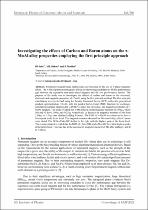 ResearchSpace
ResearchSpace
Investigating the effects of Carbon and Boron atoms on the t- MnAl alloy properties employing the first principle approach
JavaScript is disabled for your browser. Some features of this site may not work without it.
- ResearchSpace
- →
- Research Publications/Outputs
- →
- Conference Publications
- →
- View Item
| dc.contributor.author |
Sebe, ID

|
|
| dc.contributor.author |
Sithole, ME

|
|
| dc.contributor.author |
Modiba, Rosinah

|
|
| dc.date.accessioned | 2023-02-27T06:01:50Z | |
| dc.date.available | 2023-02-27T06:01:50Z | |
| dc.date.issued | 2022-12 | |
| dc.identifier.citation | Sebe, I., Sithole, M. & Modiba, R. 2022. Investigating the effects of Carbon and Boron atoms on the t- MnAl alloy properties employing the first principle approach. http://hdl.handle.net/10204/12639 . | en_ZA |
| dc.identifier.uri | http://hdl.handle.net/10204/12639 | |
| dc.description.abstract | Permanent magnet-based technologies are focusing on the use of t-phase magnetic alloys. The t-MnAl permanent magnetic alloys are interesting candidates to fill the performance gap between the expensive rare-earth-based magnets and the low performance ferrites. The purpose of the study was to investigate the effects of carbon and boron on the structural, electronic and magnetic properties of t-MnAl using the first principle method. The first principle calculations were performed using the density functional theory (DFT) within the generalized gradient approximation (GGA), with the perdew-burke-eruzer (PBE) function for exchangecorrelation potential employed in CASTEP to study the electronic, and magnetic properties of tMnAl magnets. The study revealed that t-MnAl have a total magnetic moment of 3.04µB, where Mn and Al have 2.69µB and 0.35µB respectively. A decrease in magnetic moment of Mn from 2.69µB to 1.51µB was obtained adding B atoms. The DOS of t-MnAl was observed to have a lower peak at the fermi level. The magnetic moment obtained for Mn was 0.46µB after C atoms were added. The DOS of Mn3AlC shifted to the right with the highest peak at the fermi level. The results obtained revealed that the DOS of t-Mn2AlB2 and t-Mn3AlC have their highest peaks at the fermi level. This was due to the decrease in magnetic moment of Mn after adding C and B to t-MnAl. | en_US |
| dc.format | Fulltext | en_US |
| dc.language.iso | en | en_US |
| dc.relation.uri | https://events.saip.org.za/event/225/page/546-the-proceedings-of-saip2022 | en_US |
| dc.source | 66th Annual Conference of the South African Institute of Physics, Virtual Conference, Ggeberha, 4-8 July 2022 | en_US |
| dc.subject | Density functional theory | en_US |
| dc.subject | First principle approach | en_US |
| dc.subject | Magnetic alloys | en_US |
| dc.subject | Perdew-burke-eruzer | en_US |
| dc.subject | t-MnAl alloys | en_US |
| dc.title | Investigating the effects of Carbon and Boron atoms on the t- MnAl alloy properties employing the first principle approach | en_US |
| dc.type | Conference Presentation | en_US |
| dc.description.pages | 123-126 | en_US |
| dc.description.note | Paper presented at the 66th Annual Conference of the South African Institute of Physics, Virtual Conference, Ggeberha, 4-8 July 2022 | en_US |
| dc.description.cluster | Manufacturing | en_US |
| dc.description.impactarea | Powder Metallurgy Technologies | en_US |
| dc.identifier.apacitation | Sebe, I., Sithole, M., & Modiba, R. (2022). Investigating the effects of Carbon and Boron atoms on the t- MnAl alloy properties employing the first principle approach. http://hdl.handle.net/10204/12639 | en_ZA |
| dc.identifier.chicagocitation | Sebe, ID, ME Sithole, and Rosinah Modiba. "Investigating the effects of Carbon and Boron atoms on the t- MnAl alloy properties employing the first principle approach." <i>66th Annual Conference of the South African Institute of Physics, Virtual Conference, Ggeberha, 4-8 July 2022</i> (2022): http://hdl.handle.net/10204/12639 | en_ZA |
| dc.identifier.vancouvercitation | Sebe I, Sithole M, Modiba R, Investigating the effects of Carbon and Boron atoms on the t- MnAl alloy properties employing the first principle approach; 2022. http://hdl.handle.net/10204/12639 . | en_ZA |
| dc.identifier.ris | TY - Conference Presentation AU - Sebe, ID AU - Sithole, ME AU - Modiba, Rosinah AB - Permanent magnet-based technologies are focusing on the use of t-phase magnetic alloys. The t-MnAl permanent magnetic alloys are interesting candidates to fill the performance gap between the expensive rare-earth-based magnets and the low performance ferrites. The purpose of the study was to investigate the effects of carbon and boron on the structural, electronic and magnetic properties of t-MnAl using the first principle method. The first principle calculations were performed using the density functional theory (DFT) within the generalized gradient approximation (GGA), with the perdew-burke-eruzer (PBE) function for exchangecorrelation potential employed in CASTEP to study the electronic, and magnetic properties of tMnAl magnets. The study revealed that t-MnAl have a total magnetic moment of 3.04µB, where Mn and Al have 2.69µB and 0.35µB respectively. A decrease in magnetic moment of Mn from 2.69µB to 1.51µB was obtained adding B atoms. The DOS of t-MnAl was observed to have a lower peak at the fermi level. The magnetic moment obtained for Mn was 0.46µB after C atoms were added. The DOS of Mn3AlC shifted to the right with the highest peak at the fermi level. The results obtained revealed that the DOS of t-Mn2AlB2 and t-Mn3AlC have their highest peaks at the fermi level. This was due to the decrease in magnetic moment of Mn after adding C and B to t-MnAl. DA - 2022-12 DB - ResearchSpace DP - CSIR J1 - 66th Annual Conference of the South African Institute of Physics, Virtual Conference, Ggeberha, 4-8 July 2022 KW - Density functional theory KW - First principle approach KW - Magnetic alloys KW - Perdew-burke-eruzer KW - t-MnAl alloys LK - https://researchspace.csir.co.za PY - 2022 T1 - Investigating the effects of Carbon and Boron atoms on the t- MnAl alloy properties employing the first principle approach TI - Investigating the effects of Carbon and Boron atoms on the t- MnAl alloy properties employing the first principle approach UR - http://hdl.handle.net/10204/12639 ER - | en_ZA |
| dc.identifier.worklist | 26528 | en_US |





